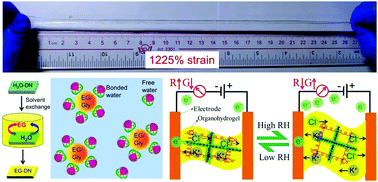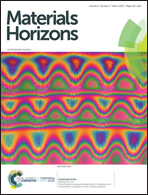An intrinsically stretchable humidity sensor based on anti-drying, self-healing and transparent organohydrogels†
Abstract
Stretchability and self-healing ability are essential attributes of modern electronic sensors for wearable applications. Herein, intrinsically ultrastretchable, self-healing and transparent humidity sensors composed of ionic κ-carrageenan/polyacrylamide (PAM) double network (DN) organohydrogels are fabricated via a facile solvent-exchange strategy. Hygroscopic ethylene glycol (EG) and glycerol (Gly) are introduced in the organohydrogels to promote both anti-drying and humidity sensing capabilities. The organohydrogel sensors display unprecedented stretchability (1225% strain) and excellent sensing performance, including fast response (0.27 s) and recovery time (0.3 s), wide relative humidity (RH) detection range (4–90%), stability and linearity. The conductance of Gly-DN sensors increases more than 543 times with increasing RH from 4% to 90%. With sufficient sensitivity, the humidity sensors can monitor human respiration with stable and repeatable output. The enhanced sensitivity and moisture-holding ability are attributed to the ready formation of hydrogen bonds between water molecules and enormous hydrophilic groups, including –OH, SO3− and –NH2, in the elaborate polymer networks and binary solvent. The hindering effect of polymer chains on the transport of conductive ions plays a key role in producing a transducing signal, which is proposed as the mechanism of the novel sensors.

- This article is part of the themed collections: Materials Horizons 10th anniversary regional spotlight collection: China, Horizons Community Board Collection: Biosensors, 2019 Materials Horizons Most Popular Articles and A selection of 2019 articles


 Please wait while we load your content...
Please wait while we load your content...